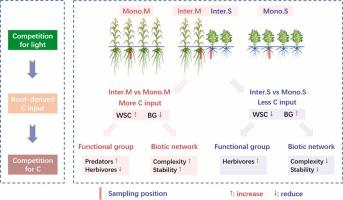Agriculture, Ecosystems & Environment ( IF 6.0 ) Pub Date : 2023-05-19 , DOI: 10.1016/j.agee.2023.108595 Guizong Zhang , Hao Yang , Weiping Zhang , T. Martijn Bezemer , Wenju Liang , Qi Li , Long Li

|
Despite increasing evidence that intercropping systems may increase crop productivity, little is known about whether and how soil biota change under interspecific competition among plants. A field experiment with maize/soybean intercropping and the corresponding monoculture systems was conducted under four nitrogen fertilization regimes to investigate the effects of interspecific plant interactions on grain yield, soil properties (β-glucosidase and water-soluble carbohydrates), and biotic communities (bacteria, fungi, and nematodes). The soils under maize and soybean in the intercropping system were sampled separately to represent intercropped maize and intercropped soybean, respectively. Compared to monocultures, the complexity and robustness of soil networks comprising bacterial, fungal, and nematode communities increased in intercropped maize soils, but densities of plant parasitic nematodes and β-glucosidase activity were reduced. Intercropped soybean soils had lower C availability due to chronic shading by maize, but a significant increase was found in saprophytic fungi, and plant parasitic nematodes compared to soybean monoculture soils. Although intercropped soybean suffered from interspecific competition with maize, the interactions within the fungal community increased for both crop species in the intercropping system. Our study demonstrates that increased carbon uptake in maize due to increased light capture in the intercropping system can facilitate nutrient cycling by altering the abundance of functional groups of soil organisms, such as saprophytic fungi, and enhancing network complexity and stability. We detected a trade-off between productivity and soil nematode diversity in the intercropping system under nitrogen fertilization, the yield of maize increased but soil nematode richness decreased at low nitrogen level, while the yield of soybean decreased but the nematode richness increased at high nitrogen level. These findings show that both trade-offs and benefits occur in intercropping systems and highlight the role of plant-soil biota interactions in such systems.
中文翻译:

作物间的种间相互作用影响玉米/大豆间作系统中的土壤功能群和网络
尽管越来越多的证据表明间作系统可以提高作物生产力,但人们对土壤生物群是否以及如何在植物间的种间竞争下发生变化知之甚少。在四种氮肥施肥方案下进行了玉米/大豆间作和相应的单作系统的田间试验,以研究种间植物相互作用对谷物产量、土壤特性(β-葡萄糖苷酶和水溶性碳水化合物)和生物群落(细菌)的影响、真菌和线虫)。间作系统中玉米和大豆下的土壤分别取样,分别代表间作玉米和间作大豆。与单一栽培相比,由细菌、真菌、间作玉米土壤中线虫和线虫群落增加,但植物寄生线虫密度和β-葡萄糖苷酶活性降低。由于玉米的长期遮荫,间作大豆土壤的碳有效性较低,但与大豆单作土壤相比,腐生真菌和植物寄生线虫显着增加。尽管间作大豆遭受了与玉米的种间竞争,但间作系统中两种作物的真菌群落内的相互作用都增加了。我们的研究表明,由于间作系统中光捕获的增加,玉米的碳吸收增加可以通过改变土壤生物(如腐生真菌)功能组的丰度并提高网络的复杂性和稳定性来促进养分循环。我们发现在施氮肥的间作系统中生产力和土壤线虫多样性之间存在权衡,玉米产量增加但土壤线虫丰富度在低氮水平下下降,而大豆产量下降但线虫丰富度在高氮水平下增加. 这些发现表明,权衡取舍和收益都发生在间作系统中,并突出了植物-土壤生物群相互作用在此类系统中的作用。











































 京公网安备 11010802027423号
京公网安备 11010802027423号